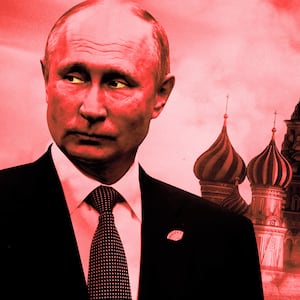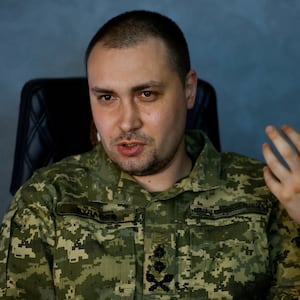Nearly two years into the conflict, the front lines of Russia’s war in Ukraine have grown relatively deadlocked, with no end in sight—forcing both Russian and Ukrainian forces to get creative.
With little ground gained in recent weeks, Russia and Ukraine are increasingly relying behind the scenes on guerrilla warfare and sabotage operations to put a dent in enemy morale and disrupt rival military plans.
In recent weeks, Ukraine attacked a key Russian rail tunnel in the Severomuysky mountains in an apparent attempt to disrupt supply lines from China and North Korea. A second train exploded just days later in the Siberian region of Buryatia. Ukrainian Special Operations Forces blew up another train last month in Melitopol that was carrying ammunition and fuel for Russian forces.
An explosion at a gunpowder factory in Russia’s Tambov region in November also raised questions about sabotage when drone fragments were found at the scene.
Assassinations or attempted assassinations in the war have piled up as well. Partisans allegedly killed Oleg Popov, a Russian-appointed official in the occupied Luhansk region of eastern Ukraine. Ukraine’s security service, the SBU, reportedly killed a Ukrainian pro-Russia lawmaker, Illya Kyva, in Russia.
The military intelligence agency of Ukraine suffered an attack in the last several weeks as well. Marianna Budanova, the wife of the chief military intelligence officer in Ukraine, Kyrylo Budanov, was poisoned, the agency said. Several other agency employees were afflicted as well.
Conventional military operations continue—Russia levied hours of drone and missile strikes in Ukraine at the dawn of the new year, marring the holiday with death and destruction, while Ukraine in recent days has been hitting back in Belgorod inside Russia. But in 2024, Russian and Ukrainian operators alike will likely increasingly rely on sabotage plots to destabilize one another as the war remains in near stalemate, veteran intelligence officers said.
These kinds of tactics are particularly pertinent at this phase of the war, according to Ronald Marks, a former CIA officer and special assistant to the assistant director of Central Intelligence for military support.
“If you’re stuck, as you are right now, with no lines moving, what you’re really looking to do is inflict as much pain as you can on both sides,” Marks told The Daily Beast.
Employing these tactics may achieve some strategic aims like killing off certain enemy figures or disrupting supply lines crucial to the war effort, as in the case of the Severomuysky Tunnel. But across the board, their aim is likely more about shaking morale, said Marks.
“The main thing about guerrilla warfare is… it’s about insecurity. It’s about keeping the troops nervous,” Marks said. “It’s about not knowing who’s supporting who behind the lines. Who can you trust?”
From the Ukrainian perspective, the sabotage operations can be aimed at sullying Vladimir Putin’s war effort in the public eye, according to Peter Schroeder, a former CIA analyst and former principal deputy national intelligence Officer for Russia and Eurasia at the National Intelligence Council in the Office of the Director of National Intelligence (ODNI).
They are “seeking to bring the war home to the Russian population as a means to undermine popular support for Putin’s war,” said Schroeder, now an adjunct senior fellow with the Transatlantic Security Program at the Center for a New American Security. “The Kremlin has deliberately tried to promote an image of normalcy inside Russia. These Ukrainian sabotage operations seek to pierce that facade.”
Russia and Ukraine have long relied on sabotage and guerrilla warfare tactics in order to gain the upper hand, even before Russia invaded Ukraine in 2022.
“The sabotage part of the war has been going on for a long time,” Schroeder said. “Both sides have shown an ability to operate clandestinely in the other country. They’ve had years to refine their operational tradecraft.”
Earlier in the war, too, sabotage shook up the playing field. The attack on the Nord Stream II pipeline in September 2022 remains as yet unsolved. Investigators from Germany, Sweden, and Denmark are on the case, while Ukraine has denied responsibility for the attack. Dutch military intelligence warned the United States about a Ukrainian plot months beforehand, according to Dutch NOS public broadcaster, German broadcaster ARD, and national weekly Die Zeit.
Ukraine attacked the Kerch bridge, a key supply route between Russia and Crimea, in 2022 as well. Attacks on the bridge have continued since, and the Ukrainian government has grown increasingly vocal in claiming responsibility for the operations.
“We have destroyed the myth of Russian invincibility. The country is a fake. The bridge is doomed. Plenty of surprises lie ahead and not just the Crimean bridge,” Vasyl Maliuk, the SBU chief, said in November of a more recent attack.
But as the war progresses, subterfuge takes on new strategic importance. For Ukraine, these operations may be aimed at pinning down Russian forces in ways that prevent them from focusing on their territorial goals.
Russia has struggled with its war effort since it began, with manpower problems along the way, including an unpopular mobilization effort and efforts from citizens to flee Russia. Throughout the war, senior Russian officers and troops have been killed at a stunning pace: Since the invasion of Ukraine, Russia has lost 315,000 men, or approximately 90 percent of the personnel it had when the war began, according to a U.S. intelligence assessment.
Rather than risk calling up additional citizens through an unpopular mobilization, Putin has resorted to building manpower by pulling from prisons, forcing migrants to join the military, and increasing the size of the military to bump up numbers without causing a domestic political stir.
Ukrainian sabotage efforts may seek to further enflame the underlying trouble in Russia’s manpower department by bogging down existing Russian forces with sabotage ops, said Schroeder.
“While still operating in Ukraine, Russian forces have to spend a lot of time trying to root out Ukrainian partisans and potential saboteurs in occupied Ukraine and Russian border regions,” Schroeder said.
Russian special services have had to resort to assigning more personnel to hunt down saboteurs, according to a release from Ukraine’s National Resistance Center last month.
The operations also serve a PR purpose for Kyiv. As doubts have emerged about the West’s willingness to continue funding Ukraine aid, the sabotage operations signal that support for a Ukrainian victory abounds.
“If you’re Ukraine… it again is a morale booster at home, saying, ‘Look, we can touch these guys anytime we want to at this point,’” Marks said. “It’s a sales point internally to the people of Ukraine, and it’s a sales point to the West. A lot of that sabotage right now is going to have to deal with Western influences.”
Moscow’s sabotage operations seem to be more aimed at disruption, according to Schroeder.
“For strategic effect, Moscow seems to be more inclined to clandestine sabotage operations to disrupt the flow of weapons from NATO countries to Ukraine,” Schroeder said.
Poland last year charged a spy ring of 16 agents allegedly working for Russia to derail and sabotage trains transporting military gear for Ukraine.
All around, the guerrilla warfare is likely intended to shake the enemy so much that they come to a negotiation table or so that they are willing to reach some form of an armistice agreement, said Marks.
“What you’re doing with that kind of guerrilla warfare or that kind of sabotage is basically you’re trying to undermine their will and their willingness to continue to engage in this strategy,” Marks said. “You’re not going to win the war that way. But what you are going to do is continue to undermine the morale, undermine the support that people would have for it.”
That “ultimately gives you a shot at coming to some kind of settlement,” he added.
The prospects for Russia look poor, according to recently revealed intelligence from the U.K. According to a report from the U.K. Ministry of Defence, Russia’s forces are in a degraded state. Over the course of 2023, the number of casualties rose to 300 per day. The increase “reflects the degradation of the Russian readiness force and their movement to a low quality, high quantity mass army,” the Ministry of Defence said.
If they continue on as is for another year, Russia will have lost half a million personnel.








